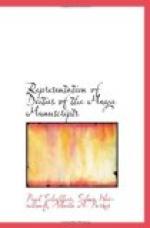1. God B: pictured 218 times. 2. " D: " 103 " 3. " E: " 98 " 4. " A: " 88 " 5. " C: " 61 " 6. " M: " 40 " 7. " F: " 33 "
Furthermore, interesting conclusions can be arrived at, by means of a list of those deities, who occur in the representations of the manuscripts, so united or grouped together as to make it evident that they must stand in some relation to one another. Mythologic combinations of this kind occur among the following deities and mythological animals:
1. In the DRESDEN MANUSCRIPT: D and C, B and C, dog and vulture, bird and serpent, B and K.
2. In the MADRID MANUSCRIPT: F and M, B and M, C and M, E and M, A and E, A and D, A and F, B and C, D and C, D and E.
3. In the PARIS MANUSCRIPT: N and K, B and K.
The most common of these combinations are those of the deities A and F, M and F, A and E, D and C. These groups are entirely intelligible, consisting of death-god and war-god, god of the travelling merchants and war-god, death-god and maize-god (as adversaries: meaning famine), night-god and deity of the polar star.
[Illustration: I. Gods.
A B C D E
F G H I K
L M N O P
II. Mythological Animals.
1 2 3 4 5 6]
* * * * * *
Transcriber’s Note:
Typographical errors:
Page
10 Footnote 1 missing final period
17 serpent-and rain-deity should read
serpent-and-rain-deity
23 Sentence ending with “and 13*c)”
does not have a period
29 manuuscripts should read manuscripts
32 repsented should read represented
33 pp 215-221 should read pp. 215-221
42 comma missing following 37b
comma missing
following 65c
Inconsistencies:
The placement of punctuation at the end of a word or phrase surrounded by quotation marks is inconsistent, usually it is placed outside the final close quotation mark but occasionally is found inside the mark.



